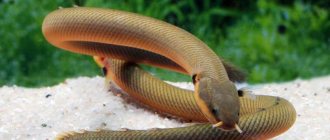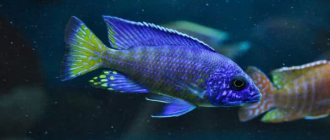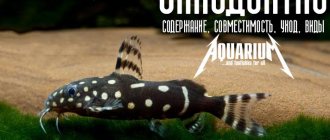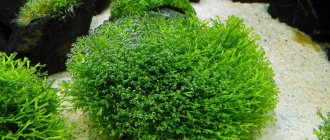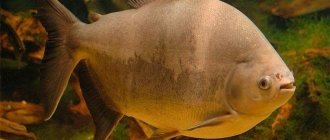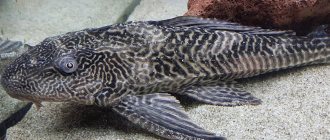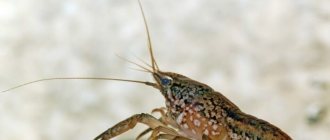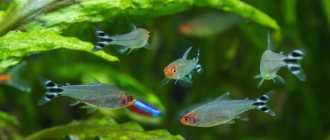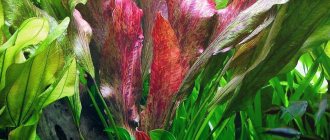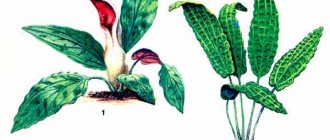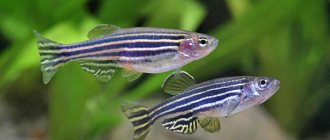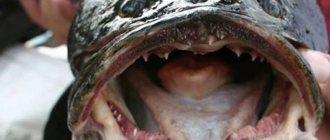Pseudotropheus are freshwater fish from the Cichlid family, living in the African Lake Malawi (Nyasa). They belong to the Mbuna group, which translates as “dweller of the rocks.” This name corresponds to the way of life of fish, because they live along the shore among many stones. There the fish hide and feed on the algae they scrape off the rocks. In addition to algae, fish eat insect larvae and mollusks.
Adult males choose the territory they like and protect it from encroachment by other fish. Adult females and juveniles stay in a flock. Females stray from the flock only during the spawning period.
Pseudotropheus are beautiful, small and not too aggressive fish. That is why they are popular among aquarists.
The inhabitants of Lake Malawi have not been fully studied. The fish interbreed with each other. Therefore, changes are constantly being made to the taxonomy of the genus.
External characteristics
The fish has an elongated oval dense body covered with small scales. All fins are well designed: a powerful symmetrical tail, a long dorsal fin, large pectoral and anal fins. The elongated muzzle ends in a large mouth with plump lips. The mouth opens so well that small fish can easily fit into it. Pseudotropheus has a flexible spine, which allows it not only to swim in a straight line, but also to bend around rocks, moving nimbly and quickly. Huge round black eyes with a rim notice any prey. Pseudotropheus is a toothy predator that demonstrates high intelligence and aggression in the aquarium. Life expectancy in captivity is 8-10 years. How long these fish live depends on the conditions that the owner of the aquarium created for them.
Description of fish
The body shape of pseudotropheus is torpedo-shaped. The maximum body length is 9-12 cm. There are large fleshy lips on the head. The mouth has special teeth for scraping algae from rocks. The dorsal fin starts from the head and extends all the way to the tail. Many species have a border on it. The anal fin has a pointed shape. It has oval spots of bright color. The caudal fin is single-lobed.
The color of fish can be different: yellow, blue, red, etc. It depends on the type of fish. All pseudotropheus have clearly visible transverse stripes on their bodies.
Fish live for about 10 years.
Types of pseudotropheus
- Pseudotropheus demasoni are extremely aggressive babies. They grow to a maximum of 9 cm, but a pair of demasoni can conquer an aquarium measuring 180-200 liters. The main body color is dark blue, with blue stripes in the shape of irregular diamonds visible across it. The fins closer to the tail can be yellowish, sandy, or brown;
- pseudotropheus zebra - usually colored in shades of blue and blue, with thin transverse stripes running throughout the body. The dorsal fin has a dark blue edge. There are fish of other colors - red (females are red-orange, males are blue), white (snowflakes), blue, yellow. Zebra grows up to 12 cm;
- pseudotropheus lombardo are small fish (8-9 cm) with clear sexual differences: the male is orange-yellow with clear red stripes, and the female is blue-blue. They are considered aggressive and capricious, so the choice of neighbors for a pawn shop must be approached responsibly;
- pseudotropheus sokolov, blue pindani, blue pseudotropheus pindani - one of the non-aggressive representatives. Shy, when frightened or excited they become covered with purple spots. In a calm state, the fish is turquoise in color with iridescence. Can be kept in a school, but shelters are needed so that the fish can hide freely. Average size – 11-12 cm;
- pseudotropheus elongatus mpanga - can grow up to 30 cm in length. The large body is blue-violet in color with dark transverse stripes (from 5 to 12 pieces). Males have several round yellow spots on the anal fin. The tail and pectoral fins may have a yellowish tint. A dark stripe stretches along the edge of the dorsal fin;
- pseudotropheus atsei itungi - each scale has a main color of blue, as well as a darker border along the edge, which is why the fish appears variegated, in a blue-black mesh. All fins have a white edge: the dorsal fins are along the upper edge; the pectoral and anal fins have white first rays. The back is usually dark, the tail is bright yellow, with dark lower rays. The fish grows up to 15 cm and is quite peaceful;
- pseudotropheus atsei mzuli - the color arrangement is the same as that of the itunga, but different shades. Mostly the color is dominated by light colors: blue, gray, silver. The fins are bright yellow. The size of an adult fish is up to 15 cm;
- Pseudotropheus acei ngara is another geographical morph of acei. The fish is completely black, with white edges on the fins;
- pseudotropheus saulosi - the females of these fish are yellow, and the mature males are blue. In males, transverse stripes are clearly visible, the fins are almost black, with a thin white edging. In an aquarium they reach 10 cm and are considered aggressive and territorial;
- Pseudotropheus flavus - in nature, this is a small group of fish that lives around the island of Chinyankwazi in Lake Malawi. They are black-striped and grow up to 10 cm. These fish are almost never found in aquariums, since the part of the lake where they live is located in a conservation area and is not caught;
- pseudotropheus crabro, chameleon cichlid - yellow fish with transverse black stripes. Among aquarists they are called “bumblebee”. In Lake Malawi, these fish reach 18-20 cm in length. Aquarium representatives are smaller than natural ones - they grow up to 9 cm;
- Pseudotropheus fainsilver is an aggressive fish of blue color with dark transverse stripes. Despite their small size (up to 10 cm), they can beat all their neighbors to death in order to win territory from them. Demanding on maintenance conditions and water parameters.
Best neighbors
When choosing neighbors for Pseudotropheus demasoni, you must adhere to an important rule - no fish with striped colors. These cichlids can even be aggressive towards neighbors with yellow stripes. It is preferable to add Mbuna to them, painted in a uniform yellow color.
When trying to divide the territory, Pseudotropheus Demasoni can attack even larger fish.
Experienced aquarists recommend considering species such as:
Labidochromis yellow
Metriaclima callainos, aka blue zebra
Metriaclima estherae, aka red zebra
You should not house a zebra or Pseudotropheus saulosi next to Pseudotropheus demasoni.
How to keep pseudotropheus
Conditions of detention require mandatory registration of the bottom according to the rules. Shelters, caves, rocks, grottoes - all this is typical for an aquarium in a marine style (pseudo-sea). By complementing the design with white soil and a blue background, the aquarist will receive a very decorative biotope, comfortable for Malawian cichlids. It is also important to observe other parameters.
Arrangement of the aquarium
- aquarium volume – at least 180-200 liters. Many species cannot tolerate their relatives as neighbors, so it is permissible to combine several Malawians in one aquarium. With overpopulation, conflicts are inevitable, which usually end in the death of the weaker enemy. Therefore, housing aggressive pseudotropheus in a smaller volume is not allowed;
- soil – fine gravel with a fraction of 3-5 mm. Any colour. A natural shade or snow-white quartz is preferable;
- a filter for an aquarium with pseudotropheus is only possible externally: it copes well with a large volume, saturates the water with useful elements and removes organic matter well;
- aeration – standard, compressor, aeration must be done around the clock;
- lighting is moderate, with shaded areas. With a good lamp, the color of the fish becomes brighter and more advantageous;
- artificial plants can easily replace natural ones. Pseudotropheus is not averse to eating any living plants: gnawing and digging them up. In such conditions, plants become not a decoration, but a headache for the aquarist. If you still decide to create the most natural atmosphere possible, egg capsules, nemphaea, and echinodorus are suitable: they have a developed root system and dense leaves;
- the decor includes piles of stones (volcanic tuff and others), ceramic pipes, locks, and jugs. The main thing is to create as many shelters as possible so that there is enough for all the inhabitants of the aquarium.
Water parameters
- temperature 24-28°C;
- hardness 4-20°;
- acidity 7.2-8.5 pH;
Maintenance and care
- weekly 30% water change;
- cleaning the soil with a siphon 1-2 times a month.
Notes
Differences that distinguish the genus Chindongo from other mbuna genera in Lake Malawi are the possession of bicuspid teeth in the anterior portions of the outer rows of both the upper and lower jaws, a small mouth in which the lower jaw is slightly shorter than the upper jaw, and a pattern of vertical stripes on their sides during all stages of development.
Pseudotropheus minutus is a similar species.
Chindongo Demasoni is sometimes confused with Pseudotropheus minutus, being similar in size and color. The differences are that in P. minutus the vertical lines stop before the caudal fin and are less distinct.
Feeding
The basis of nutrition for Malawian cichlids is plant food in the form of specialized dry mixtures to maintain color and immunity. You can add live food - fresh and frozen: bloodworms, coretra, pollock fillet. Large representatives are pampered once a week with small fish, which cichlids happily catch, showing their hunting instincts. You should not overuse live food: Mbuna tend to refuse plant foods and eat only protein foods, which leads to obesity and early death. The aquarist’s task is to strictly monitor the balance of nutrients supplied with food.
Nutrition
Herbivores in their natural habitat.
Accepts most of the offered feeds, but plant components in the form of spirulina flakes, blanched spinach, nori seaweed, etc. should form the majority of the diet. All this can be supplemented with live and frozen food, but in small quantities. Never feed meat to animals as this will harm the digestive system of these fish.
High quality cichlid mixtures, also suitable as a staple food.
Behavior and Compatibility
Aggressiveness is the main difference between most pseudotropheus. Males are especially militant: they zealously protect their favorite mink and can attack other representatives of their species. Some species are less aggressive (for example, Pseudotropheus pindani), while for others it is recommended to keep one male with 3-4 females. The female half is usually less aggressive, but there are also warlike representatives (for example, among the Demasoni).
Neighbors may only contain cichlids from Lake Malawi, comparable in size to pseudotropheus, or slightly larger. Small predatory fish will most likely be eaten.
Having reached sexual maturity, the moths become more active: they set up a nest and care for the females. The more shelters and the larger the volume of the aquarium, the higher the likelihood of different types of pseudotropheus living peacefully in the same “room”.
Since mbunas prefer to live near the bottom, cichlids from the upper layers can coexist with them.
FAQ. Answers on questions
Where do Chindongo demasoni live?
The homeland of these unusual fish is Lake Malawi, located in eastern Africa. We are talking about a natural habitat, since cichlids can be seen almost everywhere in artificial reservoirs.
How long do they live?
On average, pseudotropheus live from 8 to 10 years. But it all depends on many criteria. For example, the quality of food and the purity of water can greatly affect life expectancy.
What do Pseudotropheus demasoni eat?
The majority of their diet should consist of plant-based foods. This is important, because the health of the fish depends on the composition of the food. It is also sometimes allowed to use natural plant foods.
TOP 11 unpretentious aquarium fish TOP 10 largest aquarium fish TOP 20 beautiful aquarium fish TOP 12 most expensive aquarium fish
Breeding and reproduction
Pseudotropheus reproduces in a home aquarium without the use of a separate spawning tank. Sexual maturity occurs at approximately 1 year of age.
The process of reproduction of pseudotropheus
These fish bear their young in their mouths. During one spawning, the male fertilizes up to a hundred eggs, after which the female collects them in her mouth. During this time (2-3 weeks) she does not eat anything. Therefore, preparation for spawning begins with intensive feeding.
For some time after birth, the fry are still attached to their mother: in case of any danger, they hide in her mouth. Male pseudotropheus may not be the most caring fathers and may eat weak and clumsy children. In addition, other inhabitants of the aquarium always perceive juveniles as prey. When spawning in a community aquarium, a maximum of 2-3 individuals survive to adulthood. Therefore, if there is a need to preserve more offspring, it is still recommended to place the female in a spawning area. The water parameters in it are similar to a general aquarium; the size can be significantly smaller (50-60 l).
When using a spawning tank, it is better to remove the female as soon as the fry begin to swim independently. They are fed with the usual junior grade starter food.
Differences between a male and a female
Sexual maturity in fish of this species occurs at 9-12 months. But most of them have sex differences long before the time when it is time to spawn for the first time. Males are larger and their colors are brighter. Female tabby males have spots on their bodies.
Females differ from males not only in appearance, but also in their behavior: males are extremely aggressive, while females are calmer. In general, the colors of these cichlids, even within the same species, are so diverse that in order to distinguish a male from a female, you need to know which species this pseudotropheus belongs to
Diseases and their prevention
Typically, adult Malawian cichlids have excellent immunity. But if the conditions of detention are violated, it may decrease and the appearance of diseases:
- fungal infections;
- bacterial foci;
- viral diseases;
- mechanical damage after fights with neighbors.
The disease manifests itself as lethargy, loss of shine in scales, ulcers on the body, and dropsy. Some parasitic infections (such as ichthyophthyriasis) are treated by adding medication to the water. Others (bacterial “Malawi disease”) are unfortunately incurable.
Prevention consists of regular aquarium maintenance, keeping equipment clean and quarantining all fish before adding them to the aquarium.
Reviews
I have been breeding Pindani pseudotropheus for about 5 years. I liked the look for its unpretentiousness and bright blue color. This color looks beautiful in clear water against a background of green algae. When breeding, I don’t remove females, since she hides her future offspring in her mouth. Matveeva Olga Vasilievna, 56 years old, Vladivostok
I liked the red look for its bright color. The species is unpretentious, males are not aggressive, and get along well with their neighbors. Advice for beginner aquarists: for a comfortable life, it is better to install decorative caves, grottoes, and large stones resembling rocks in the aquarium. Ivan, St. Petersburg
